Cnidarian - Study guides, Class notes & Summaries
Looking for the best study guides, study notes and summaries about Cnidarian? On this page you'll find 41 study documents about Cnidarian.
Page 2 out of 41 results
Sort by
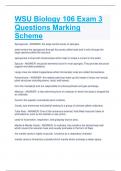
-
WSU Biology 106 Exam 3 Questions Marking Scheme
- Exam (elaborations) • 18 pages • 2024
- Available in package deal
-
- $12.99
- + learn more
WSU Biology 106 Exam 3 Questions Marking Scheme Spongocoel - ANSWER- the large central cavity of sponges. water enters the spongocoel through tiny pores called ostia and it exits through the large opening called the osculum. spongocoel is lined with choanocytes which help to create a current in the water. Spicule - ANSWER- structural elements found in most sponges. They provide structural support and deter predators. Large ones are called megascleres while microscopic ones are calle...
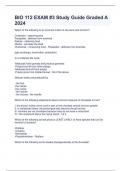
-
BIO 112 EXAM #3 Study Guide Graded A 2024
- Exam (elaborations) • 8 pages • 2024
-
- $11.49
- + learn more
Which of the following is an incorrect match of structure and function? Cnidocyte - capturing prey Parapodia - defense from enemies Radula - obtaining food Mantle - secretes the shell Chelicerae - consuming food - Parapodia - defense from enemies (gas exchange, locomotion, protection) In a cnidarian life cycle, -Medusae have gonads and produce gametes -Polyps bud off from other polyps -Medusae bud off from polyps -Polyps grow from ciliated larvae - All of the above ...
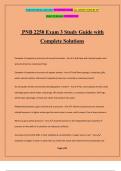
-
PNB 2250 Exam 3 Study Guide with Complete Solutions
- Exam (elaborations) • 43 pages • 2024
- Available in package deal
-
- $12.49
- + learn more
©GRACEAMELIA 2024/2025 ACADEMIC YEAR. ALL RIGHTS RESERVED FIRST PUBLISH OCTOBER 2024 Page 3/43 Name one aquatic and one terrestrial animal that has the opposite physiological setup: one that lacks a circulatory system (at least one used primarily for gas exchange) and respires using bulk flow of the medium (water or air) - Ans:-Bulk flow animals have no circulatory system Aquatic: sponge, cnidarian Terrestrial: insect (tracheal system and spiracles) Name an aquatic and terrestrial anima...
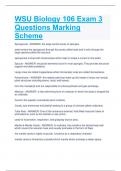
-
WSU Biology 106 Exam 3 Questions Marking Scheme
- Exam (elaborations) • 18 pages • 2023
- Available in package deal
-
- $13.99
- + learn more
WSU Biology 106 Exam 3 Questions Marking Scheme Spongocoel - ANSWER- the large central cavity of sponges. water enters the spongocoel through tiny pores called ostia and it exits through the large opening called the osculum. spongocoel is lined with choanocytes which help to create a current in the water. Spicule - ANSWER- structural elements found in most sponges. They provide structural support and deter predators. Large ones are called megascleres while microscopic ones are calle...

-
ABC Book of Biology
- Exam (elaborations) • 3 pages • 2024
-
- $10.39
- + learn more
ABC Book of Biology A is for Amino Acid Amino Acids are building blocks that make up proteins. They are composed of carbon, hydrogen and oxygen and nitrogen and side chains. Combinations of 20 molecules that make up proteins. B is for Bacteria Bacteria are one of the six kingdoms of life. They are unicellular microorganisms lacking organelles and a nucleus. Some can cause disease. C is for Cell Cells are the basic unit of life. All living things are made up of one or more cells. Th...

-
WSU Biology 106 Exam 3 Questions Marking Scheme
- Exam (elaborations) • 18 pages • 2023
-
Available in package deal
-
- $13.39
- + learn more
WSU Biology 106 Exam 3 Questions Marking Scheme Spongocoel - ANSWER- the large central cavity of sponges. water enters the spongocoel through tiny pores called ostia and it exits through the large opening called the osculum. spongocoel is lined with choanocytes which help to create a current in the water. Spicule - ANSWER- structural elements found in most sponges. They provide structural support and deter predators. Large ones are called megascleres while microscopic ones are ca...

-
Campbell Biology Chapter 50 Study Guide
- Exam (elaborations) • 9 pages • 2024
- Available in package deal
-
- $10.49
- + learn more
Campbell Biology Chapter 50 Study Guide sensory transduction - Answer️️ -the conversion of stimulus energy into a change in the membrane potential of a sensory receptor receptor potential - Answer️️ -A slow, graded electrical potential produced by a receptor cell in response to a physical stimulus transmission - Answer️️ -communication by means of transmitted signals sensory reception - Answer️️ -The detection of a stimulus by sensory cells sensory receptor - Answer️️...

-
Campbell Biology Chapter 33 Study Guide with Complete Solutions
- Exam (elaborations) • 13 pages • 2024
-
- $9.99
- + learn more
Campbell Biology Chapter 33 Study Guide with Complete Solutions Invertebrates - Answer️️ -Animals without a backbone. About 95% of known animal species. Calcarea and Silicea - Answer️️ -phylum that includes sponges; no symmetry, tissues, body cavity, organs, nervous system; basal animals; mostly marine; contain spicules; most are hermaphrodites; free-swimming during larval stage and sessile (non motile) as adults; suspension/filter feeders Suspention feeders - Answer️️ -small...
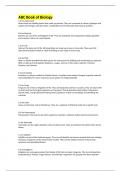
-
ABC Book of Biology
- Exam (elaborations) • 3 pages • 2024
-
- $9.59
- + learn more
ABC Book of Biology A is for Amino Acid Amino Acids are building blocks that make up proteins. They are composed of carbon, hydrogen and oxygen and nitrogen and side chains. Combinations of 20 molecules that make up proteins. B is for Bacteria Bacteria are one of the six kingdoms of life. They are unicellular microorganisms lacking organelles and a nucleus. Some can cause disease. C is for Cell Cells are the basic unit of life. All living things are made up of one or more cells. Th...
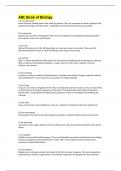
-
ABC Book of Biology
- Exam (elaborations) • 3 pages • 2024
-
- $10.39
- + learn more
ABC Book of Biology A is for Amino Acid Amino Acids are building blocks that make up proteins. They are composed of carbon, hydrogen and oxygen and nitrogen and side chains. Combinations of 20 molecules that make up proteins. B is for Bacteria Bacteria are one of the six kingdoms of life. They are unicellular microorganisms lacking organelles and a nucleus. Some can cause disease. C is for Cell Cells are the basic unit of life. All living things are made up of one or more cells. Th...

Do you wonder why so many students wear nice clothes, have money to spare and enjoy tons of free time? Well, they sell on Stuvia! Imagine your study notes being downloaded a dozen times for $15 each. Every. Single. Day. Discover all about earning on Stuvia


